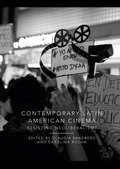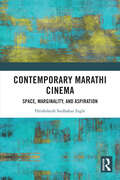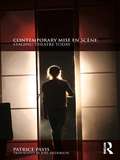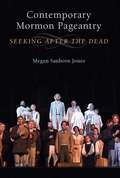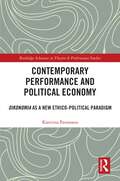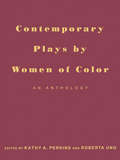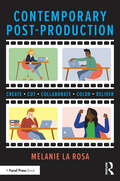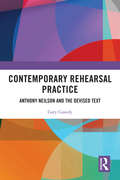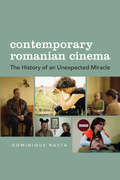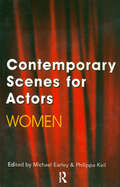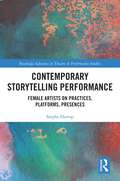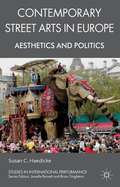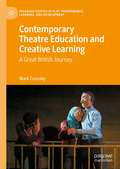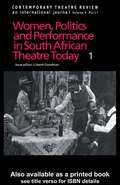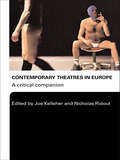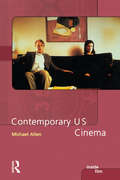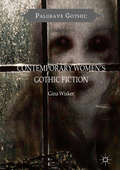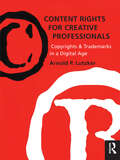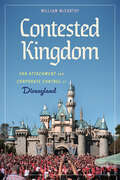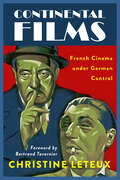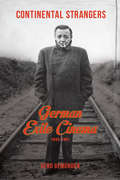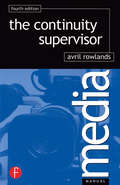- Table View
- List View
Contemporary Latin American Cinema: Resisting Neoliberalism?
by Carolina Rocha Claudia SandbergContemporary Latin American Cinema investigates the ways in which neoliberal measures of privatization, de-regularization and austerity introduced in Latin America during the 1990s have impacted film production and film narratives. The collection examines the relationship between economic policies and the films that depict recent transformations in many Latin American countries, demonstrating how contemporary Latin American film has not only criticized and resisted, but also benefitted from neoliberal advancements. Based on films produced in Argentina, Bolivia, Brazil, Chile, Colombia, Ecuador, Mexico and Peru since 2010, the fourteen case studies illustrate neoliberalism’s effects, from big industries to small national cinemas. It also shows the new types of producers that have emerged, and the novel patterns of distribution, exhibition and consumption that shape and influence the Latin American filmscape. Through industry studies, reception analyses and close readings, this book establishes an informative and accessible text for scholars and students alike.
Contemporary Marathi Cinema: Space, Marginality, and Aspiration
by Hrishikesh Sudhakar InglePost-millennial Marathi cinema is a dynamic and expanding practice that is celebrated as a “new-wave” but has not received much critical engagement. This book presents the first comprehensive inquiry of contemporary films and examines their textual, industrial, and cultural intersections to understand what constitutes the “new-ness” of Marathi cinema. Establishing the vernacular particularity of Marathi cinema, the book argues that newage films are actively engaged in a reflexive intellectual and social critique as a mark of new filmmaking in India. In the diversity of genres and topics handled by Marathi filmmakers since 2004 this study identifies four broad affective topographies for analysis – an imagery of nostalgia underpinning the narrative strategies of Marathi films, the articulation of social aspiration as a theme as well as a societal dialectic, an experiential reflexivity in the representation of Dalit and marginal narratives, and a mediatic network of border-crossings through transnational influences on films.Contemporary Marathi Cinema: Space, Marginality, and Aspiration offers a critical dialogue on broad issues of film policy, multiplex economics, genre forms, queer politics, and neoliberal contexts. It will be indispensable to students and researchers of Indian cinemas, regional filmmaking, media, cultural studies, popular culture and performance, literature, and South Asian studies, and will also be of interest to filmmakers and cinephiles.
Contemporary Mise en Scène: Staging Theatre Today
by Patrice Pavis‘We have good reason to be wary of mise en scène, but that is all the more reason to question this wariness ... it seems that images from a performance come back to haunt us, as if to prolong and transform our experience as spectators, as if to force us to rethink the event, to return to our pleasure or our terror.’ – Patrice Pavis, from the foreword Contemporary Mise en Scène is Patrice Pavis’s masterful analysis of the role that staging has played in the creation and practice of theatre throughout history. This stunningly ambitious study considers: the staged reading, at the frontiers of mise en scène; scenography, which sometimes replaces staging; the reinterpretation of classical and contemporary works; the development of intercultural theatre and ritual; new technologies and their usage live on the stage; the postmodern practice of deconstruction. But it also applies sustained critical attention to the challenges of defining mise en scène, of tracking its development, and of exploring its possible futures. Joel Anderson’s powerful new translation lucidly realises Pavis’s investigation of the changing possibilities for stagecraft in the context of performance art, physical theatre and modern theory.
Contemporary Mormon Pageantry: Seeking After the Dead
by Megan S JonesIn Contemporary Mormon Pageantry, theater scholar Megan Sanborn Jones looks at Mormon pageants, outdoor theatrical productions that celebrate church theology, reenact church history, and bring to life stories from the Book of Mormon. She examines four annual pageants in the United States-the Hill Cumorah Pageant in upstate New York, the Manti Pageant in Utah, the Nauvoo Pageant in Illinois, and the Mesa Easter Pageant in Arizona. The nature and extravagance of the pageants vary by location, with some live orchestras, dancing, and hundreds of costumed performers, mostly local church members. Based on deep historical research and enhanced by the author's interviews with pageant producers and cast members as well as the author's own experiences as a participant-observer, the book reveals the strategies by which these pageants resurrect the Mormon past on stage. Jones analyzes the place of the productions within the American theatrical landscape and draws connections between the Latter-day Saints theology of the redemption of the dead and Mormon pageantry in the three related sites of sacred space, participation, and spectatorship. Using a combination of religious and performance theory, Jones demonstrates that Mormon pageantry is a rich and complex site of engagement between theater, theology, and praxis that explores the saving power of performance.
Contemporary Performance and Political Economy: Oikonomia as a New Ethico-Political Paradigm (Routledge Advances in Theatre & Performance Studies)
by Katerina ParamanaContemporary Performance and Political Economy examines haunting concepts, relations, and artworks that demand our attention. Under capitalism, political and ethical considerations are subordinated to economic ones, and this subordination creates ghost worlds. Performance works, however, can offer insights into alternative politico-economic models. In this major contribution to the fields of contemporary performance and political economy, Katerina Paramana proposes that the investigation of performance works as economies can make the insights performance works offer visible. She positions the examination in relation to contemporary critiques of capitalism, neo-feudalism, and their by-products, and proposes and develops the notion of "oikonomia" as a means to theorize artworks which, through their house (oikos) rules (nomoi), propose ethico-political challenges to the economies in which they are embedded. For this, Paramana looks at politically positioned performance works created and presented in Cuba, Europe, Mexico, the UK, and the US. Her interest is in the politics, ethics, and effects of these works’ "house rules", and the insights they offer to the reconceptualization of political economy. Ultimately, this book aims to transform our understanding of economy’s purpose. It contributes to the development of a new ethico-political paradigm upon which a reconceptualization of political economy can be based. This inspiring study seeks to keep the fire for change alive by demonstrating that political economies, much like performances, are experiments that can be changed.This work will be of great interest to students and scholars in performance studies, theatre, visual cultures, politics, cultural studies, dance, and visual arts, and critical theorists.
Contemporary Plays by Women of Color: An Anthology
by Roberta UnoContemporary Plays by Women of Color is a ground-breaking anthology of eighteen new and recent works by African American, Asian American, Latina American and Native American playwrights. This compelling collection includes works by award-winning and well-known playwrights such as Anna Deavere Smith, Cherrie Moraga, Pearl Cleage, Marga Gomez and Spiderwoman, as well as many exciting newcomers. Contemporary Plays by Women of Color is the first anthology to display such an abundance of talent from such a wide range of today's women playwrights. The plays tackle a variety of topics - from the playful to the painful - and represent numerous different approaches to playmaking. The volume also includes: * an invaluable appendix of published plays by women of color * biographical notes on each writer * the production history of each play Contemporary Plays by Women of Color is a unique resource for practitioners, students and lovers of theatre, and an inspiring addition to any bookshelf.
Contemporary Post-Production: Create, Cut, Collaborate, Color, Deliver
by Melanie La RosaContemporary Post-Production is an engaging and insightful guide through the often fraught and stressful phase of post-production. It brings the art and craft of editing to life, describes contemporary workflows, and demonstrates how to break the post-production process into manageable phases. It also explores editing approaches used by five award-winning filmmakers across fiction films, documentaries, and interactive works.This text addresses key questions about the editor’s role in shaping a story, the roles of various members of the post-production team, when and how to delegate to specialists, and how to engage in the most efficient and constructive conversations with them. Another key focus is on career pathways, with each featured filmmaker sharing how they broke into the editing field and offering advice on building a lasting career.The featured filmmakers reflect a diversity of life experiences and work, and their interviews shed light on the people behind the process. They provide guidance on cutting-edge tools, such as the most essential software to know, how they incorporate GenAI into their work, and how they utilize remote workflows. A brief look at the past offers valuable context for understanding the future, including a section on key innovators in film history. Examples include Alice Guy-Blaché’s pioneering use of sync sound and Oscar Micheaux’s re-editing techniques to navigate censorship – stories that illustrate past innovations and continue to inspire today’s filmmakers to push creative and technical boundaries.Each technical chapter includes class activities and exercises to help readers practice specific skills. Additional resources provide ample opportunities for continued learning.This book serves as an invaluable resource for students in post-production courses and anyone looking to enter the industry or refine their skills.
Contemporary Rehearsal Practice: Anthony Neilson and the Devised Text
by Gary CassidyThis book provides the first comprehensive study of Anthony Neilson’s unconventional rehearsal methodology. Neilson’s notably collaborative rehearsal process affords an unusual amount of creative input to the actors he works with and has garnered much interest from scholars and practitioners alike. This study analyses material edited from 100 hours of footage of the rehearsals of Neilson’s 2013 play Narrative at the Royal Court Theatre, as well as interviews with Neilson himself, the Narrative cast, and actors from other Neilson productions. Replete with case studies, Gary Cassidy also considers the work of other relevant practitioners where appropriate, such as Katie Mitchell, Forced Entertainment, Joan Littlewood, Peter Brook, Complicite’s Simon McBurney, Stanislavski and Sarah Kane. Contemporary Rehearsal Practice will be of great interest to scholars, students and practitioners of theatre and performance and those who have an interest in rehearsal studies.
Contemporary Representations of Forced Migration in Europe: Beyond Regime and Refuge (Palgrave Studies in Literature, Culture and Human Rights)
by Fiona Barclay Beatrice IveyThis book engages with current debates around refugeedom by examining cultural production that represents and interrogates the construction of refugees and the refugee experience on the borders of contemporary Europe. The refugee subject is produced by discursive regimes and border practices inherited from colonial projects that construct the diametrically opposed concepts of citizen and refugee, and their attendant administrative sub-categories. In the early twenty-first century these categories have been strengthened by the politicisation of forced migration and the hardening of ‘Fortress Europe’. While the predominant response to the increasing numbers of refugees seeking asylum in Europe has been to harden the borders (regime), on the one hand, or to stress the common humanity of those displaced (refuge), on the other, this volume argues that both approaches result in refugees becoming objectified, othered, and abstracted as vectors ofexile. It explores what recent cultural production can achieve in engaging with and representing issues of dispossession, detention and resettlement, and probes the limits of artistic potential to mediate the refugee experience. It examines transnational approaches to cultural production that both occupy and exceed the borders of Europe, with a focus on borderscapes, spaces of detention, and (neo-)colonialism. Bringing together original contributions from an international range of scholars, it analyses contemporary textual and visual representations of forced migration to argue that other forms of solidarity and hospitality towards refugees in Europe and beyond must be possible.
Contemporary Romanian Cinema
by Dominique NastaOver the last decade, audiences worldwide have become familiar with highly acclaimed films from the Romanian New Wave such as 4 Months, 3 Weeks and 2 Days (2007), The Death of Mr. Lazarescu (2005), and 12:08 East of Bucharest (2006). However, the hundred or so years of Romanian cinema leading to these accomplishments have been largely overlooked. This book is the first to provide in-depth analyses of essential works ranging from the silent period to contemporary productions. In addition to relevant information on historical and cultural factors influencing contemporary Romanian cinema, this volume covers the careers of daring filmmakers who approached various genres despite fifty years of Communist censorship. An important chapter is dedicated to Lucian Pintilie, whose seminal work, Reconstruction (1969), strongly inspired Romania's 21st-century innovative output. The book's second half closely examines both the 'minimalist' trend (Cristian Mungiu, Cristi Puiu, Corneliu Porumboiu, Radu Muntean) and the younger, but no less inspired, directors who have chosen to go beyond the 1989 revolution paradigm by dealing with the complexities of contemporary Romania.
Contemporary Romanian Cinema: The History of an Unexpected Miracle
by Dominique NastaOver the last decade, audiences worldwide have become familiar with highly acclaimed films from the Romanian New Wave such as 4 Months, 3 Weeks and 2 Days (2007), The Death of Mr. Lazarescu (2005), and 12:08 East of Bucharest (2006). However, the hundred or so years of Romanian cinema leading to these accomplishments have been largely overlooked. This book is the first to provide in-depth analyses of essential works ranging from the silent period to contemporary productions. In addition to relevant information on historical and cultural factors influencing contemporary Romanian cinema, this volume covers the careers of daring filmmakers who approached various genres despite fifty years of Communist censorship. An important chapter is dedicated to Lucian Pintilie, whose seminal work, Reconstruction (1969), strongly inspired Romania's 21st-century innovative output. The book's second half closely examines both the 'minimalist' trend (Cristian Mungiu, Cristi Puiu, Corneliu Porumboiu, Radu Muntean) and the younger, but no less inspired, directors who have chosen to go beyond the 1989 revolution paradigm by dealing with the complexities of contemporary Romania.
Contemporary Scenes for Actors: Women
by Michael Earley Philippa KeilFirst Published in 1999. Routledge is an imprint of Taylor & Francis, an informa company.
Contemporary Storytelling Performance: Female Artists on Practices, Platforms, Presences (Routledge Advances in Theatre & Performance Studies)
by Stephe HarropThis book focuses on a rising generation of female storytellers, analysing their innovation in interdisciplinary collaboration, and their creation of new multimedia platforms for story-led performance. It draws on an unprecedented series of in-depth interviews with artists including Jo Blake, Xanthe Gresham-Knight, Mara Menzies, Clare Murphy, Debs Newbold, Rachel Rose Reid, Sarah Liisa Wilkinson, and Vanessa Woolf, while Sally Pomme Clayton’s reflections on her extraordinary four-decade career provide long-term context for these cutting-edge conversations. Blending ethnographic research and performance analysis, the book documents the working lives of professional storytelling artists. It sheds light on the practices, values, aspirations, and achievements of a generation actively re-defining storytelling as a contemporary performance practice, taking on topics from ecology and maternity to griefwork and neuroscience, while working collaboratively with diverse creative partners to generate new, inclusive presences for a traditionally-inspired artform. This book will be of great interest to students, scholars, and practitioners in drama, theatre, performance, creative writing, education, and media.
Contemporary Street Arts in Europe
by Susan C. HaedickeStreet theatre invades a public space, shakes it up and disappears, but the memory of the disruption haunts the site for audiences who experience it. This book looks at how the dynamic interrelationship of performance, participant and place creates a politicized aesthetic of public space that enables the public to rehearse democratic practices.
Contemporary Theatre Education and Creative Learning: A Great British Journey (Palgrave Studies In Play, Performance, Learning, and Development)
by Mark CrossleyThis book considers the state of contemporary theatre education in Great Britain is in two parts. The first half considers the national identities of each of the three mainland nations of England, Scotland, and Wales to understand how these differing identities are reflected and refracted through culture, theatre education and creative learning. The second half attends to 21st century theatre education, proposing a more explicit correlation between contemporary theatre and theatre education. It considers how theatre education in the country has arrived at its current state and why it is often marginalised in national discourse. Attention is given to some of the most significant developments in contemporary theatre education across the three nations, reflecting on how such practice is informed by and offers a challenge to conceptions of place and nation. Drawing upon the latest research and strategic thinking in culture and the arts, and providing over thirty interviews and practitioner case studies, this book is infused with a rigorous and detailed analysis of theatre education, and illuminated by the voices and perspectives of innovative theatre practitioners.
Contemporary Theatre Review: Women, Politics and Performance in South African Theatre Today (Contemporary Theatre Review Ser. #Vols. 9, Pts. 1.)
by Lizbeth GoodmanFirst published in 1999, 'Women, Politics and Performance in South African Theatre Today' is an important contribution to Performance.
Contemporary Theatres in Europe: A Critical Companion
by Nicholas Ridout Joe KelleherThrough specific examples, case studies and essays by specialist writers, academics, and a new generation of theatre researchers, this collection of specially commissioned essays looks at current theatre practices across Europe. From Théatre du Soleil to Socìetas Raffaello Sanzio, the authors reconsider the possibilities of theatre practice, its relation to history and location and its place in Europe at the turn of the twenty-first century. Contemporary Theatres in Europe examines a wide range of topics including: mainstream European theatre experimental performance music theatre theatre for children dance theatre. Tailor-made for students, offering clear examples of different ways of thinking and writing about performance, this is a richly detailed introduction which brings key themes to life for all students of European theatre.
Contemporary US Cinema (Inside Film)
by Michael AllenContemporary U.S. Cinema is a forceful exploration of the tumultuous changes that have dominated the shifting landscape of American film-making over the past three decades. From the explosive release of Easy Rider to the excesses of Heaven's Gate and the comic book figures of Spider-Man, its aim is to examine the economic, social and cultural contexts of mainstream and independent American films. The book divides into nine provocative chapters with material on: the most significant individual film-makers, such as Scorsese, Coppola and Lucas, as well as independent film-makers like Jarmusch and Anders the careers of leading actors of the last thirty years, such as Jack Nicholson, Robert Redford and Julia Roberts, whilst exploring the powerful position of the film star in the modern American film-making process the economics of Contemporary U.S. Cinema with particular reference to the tortuous journey from production, distribution and exhibition of Waterworld and Titanic the artistic influence of foreign film-makers, such as François Truffaut and Jean-Luc Godard, and explores Hollywood's increasing dominance and reliance on the global market genres, sequels and the recent developments in computer-based technologies, using examples from The Godfather I - III, The Matrix, the Star Wars saga and remakes from Shaft to Ocean's Eleven The book is illustrated with stills throughout and includes a bibliography and annotated further reading list.
Contemporary Women's Gothic Fiction: Carnival, Hauntings and Vampire Kisses (Palgrave Gothic)
by Gina WiskerThis book revives and revitalises the literary Gothic in the hands of contemporary women writers. It makes a scholarly, lively and convincing case that the Gothic makes horror respectable, and establishes contemporary women’s Gothic fictions in and against traditional Gothic. The book provides new, engaging perspectives on established contemporary women Gothic writers, with a particular focus on Angela Carter, Margaret Atwood and Toni Morrison. It explores how the Gothic is malleable in their hands and is used to demythologise oppressions based on difference in gender and ethnicity. The study presents new Gothic work and new nuances, critiques of dangerous complacency and radical questionings of what is safe and conformist in works as diverse as Twilight (Stephenie Meyer) and A Girl Walks Home Alone (Ana Lily Amirpur), as well as by Anne Rice and Poppy Brite. It also introduces and critically explores postcolonial, vampire and neohistorical Gothic and women’s ghost stories.
Content Rights for Creative Professionals: Copyrights & Trademarks in a Digital Age
by Arnold P. LutzkerContent Rights for Creative Professionals is for professionals and students working in all areas of media (film/video, photography, multimedia, web, graphics, and broadcast) who need to know what the law requires and how they should properly utilize copyrights and trademarks. This book outlines critical concepts and applies them with explanations in real-life applications, including many cases from the author's own practice as well as those of various media professionals. This 256 page text is a practical guide designed to provide its reader with a firm understanding of the principles underlying the ownership and use of content, so that when questions arise, they will be able to make correct, well-informed decisions-whether concerning their personal works, or works of others that a company wishes to copyright or trademark. In addition, the reader will be more capable of exercising sound judgment in structuring employment and contract relationships and of acquiring and/or licensing works, which are at the core of the business of communicating.
Contested Kingdom: Fan Attachment and Corporate Control at Disneyland
by William McCarthyIn Contested Kingdom: Fan Attachment and Corporate Control at Disneyland, William McCarthy presents a groundbreaking study centered on the history of Disneyland and Disney theme park enthusiasts. Focusing on two unexplored yet interconnected phenomena—the dynamic relationship between the Disney corporation and Southern Californian fans in both online and physical park settings over a span of more than three decades—this volume sheds new light on the meaning and purpose of Disneyland. Through a comprehensive analysis of the interwoven dimensions of individuals, place, and cognitive, affective, and behavioral processes, McCarthy explores the fervent sense of place attachment experienced by the approximately one million annual passholders who visit the park. McCarthy’s analysis extends beyond the physical world of Disneyland by delving into the evolution of Disney fandom, discourse, commerce, and social formations in online social platforms like Usenet, web discussion boards, and social media. By employing a mixed-methods approach incorporating interviews, participant observation, surveys, and data analysis, this study establishes a novel analytical framework for comprehending the interrelationships between the Disney corporation, its fan communities, and online social platforms. As the first in-depth longitudinal analysis of the ongoing struggle on successive social platforms between fan users and a corporate entity, Contested Kingdom provides valuable insights for scholars and future investigations.
Continental Films: French Cinema under German Control (Wisconsin Film Studies)
by Christine LeteuxFrom 1940 to 1944, the German-owned Continental Films dominated the French film landscape, producing thirty features throughout the Nazi occupation. Charged with producing entertaining and profitable films rather than propaganda, producer Alfred Greven employed some of the greatest French actors and most prestigious directors of the time, including Maurice Tourneur, Henri Decoin, Henri-Georges Clouzot, and Marcel Carné. Using recently opened archival documents, including reams of testimony from the épuration (purification) hearings conducted shortly after the war, Christine Leteux has produced the most authoritative and complete history of the company and its impact on the French film industry—both during the war and after. She captures the wide range of responses to the firm from those who were eager to work for a company whose ideology matched their own, to others who reluctantly accepted contracts out of necessity, to those who abhorred the company but felt compelled to participate in order to protect family members from Nazi reprisals. She examines not only the formation and management of Continental Films but also the personalities involved, the fraught and often deadly political circumstances of the period, the critical reception of the films, and many of the more notorious and controversial events. As Bertrand Tavernier explains in his foreword, Leteux overturns many of the preconceptions and clichés that have come to be associated with Continental Films. Published to rave reviews in French and translated by the author into English, this work shatters expectations and will reinvigorate study of a lesser-known but significant period of French film history.
Continental Strangers: German Exile Cinema, 1933-1951
by Gerd GemündenHundreds of German-speaking film professionals took refuge in Hollywood during the 1930s and 1940s, making a lasting contribution to American cinema. Hailing from Austria, Hungary, Poland, Russia, and the Ukraine, as well as Germany, and including Ernst Lubitsch, Fred Zinnemann, Billy Wilder, and Fritz Lang, these multicultural, multilingual writers and directors betrayed distinct cultural sensibilities in their art. Gerd Gemünden focuses on Edgar G. Ulmer's The Black Cat (1934), William Dieterle's The Life of Emile Zola (1937), Ernst Lubitsch's To Be or Not to Be (1942), Bertolt Brecht and Fritz Lang's Hangmen Also Die (1943), Fred Zinnemann's Act of Violence (1948), and Peter Lorre's Der Verlorene (1951), engaging with issues of realism, auteurism, and genre while tracing the relationship between film and history, Hollywood politics and censorship, and exile and (re)migration.
Continental Strangers: German Exile Cinema, 1933-1951 (Film and Culture Series)
by Gerd GemündenHundreds of German-speaking film professionals took refuge in Hollywood during the 1930s and 1940s, making a lasting contribution to American cinema. Hailing from Austria, Hungary, Poland, Russia, and the Ukraine, as well as Germany, and including Ernst Lubitsch, Fred Zinnemann, Billy Wilder, and Fritz Lang, these multicultural, multilingual writers and directors betrayed distinct cultural sensibilities in their art. Gerd Gemünden focuses on Edgar G. Ulmer's The Black Cat (1934), William Dieterle's The Life of Emile Zola (1937), Ernst Lubitsch's To Be or Not to Be (1942), Bertolt Brecht and Fritz Lang's Hangmen Also Die (1943), Fred Zinnemann's Act of Violence (1948), and Peter Lorre's Der Verlorene (1951), engaging with issues of realism, auteurism, and genre while tracing the relationship between film and history, Hollywood politics and censorship, and exile and (re)migration.
Continuity Supervisor
by Avril RowlandsThe Continuity Supervisor is a practical guide to the basics of continuity, designed to be of use both to the newcomer and those more experienced. Formerly titled 'The Continuity Handbook: a guide for single-camera shooting, this new edition covers the latest technological changes which affect the Continuity Supervisor. Avril Rowlands worked at the BBC for any years as a PA. She has been involved in specialised training for the television industry and major film and television colleges. Her highly acclaimed residential courses attract students from major television companies worldwide. She is also a writer and independent television producer.
